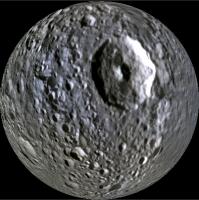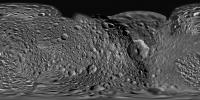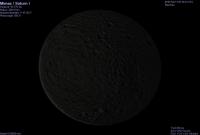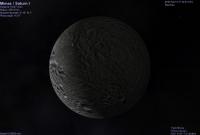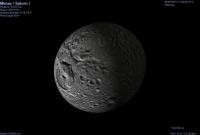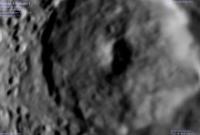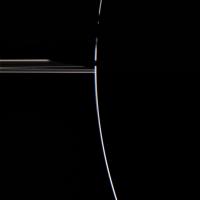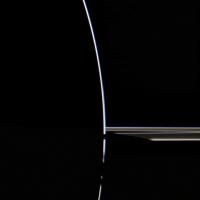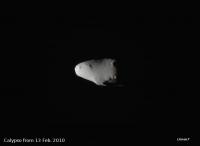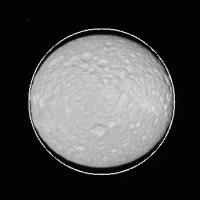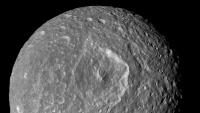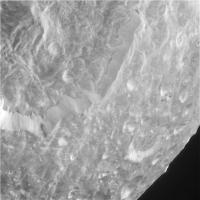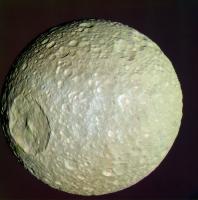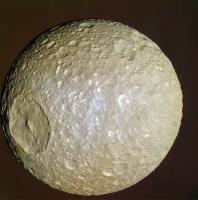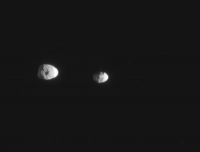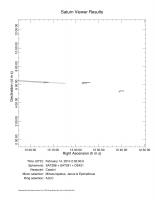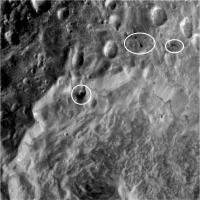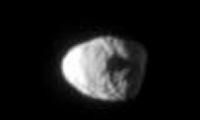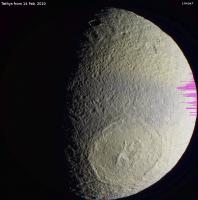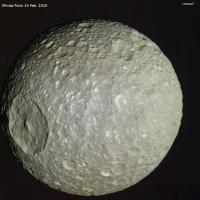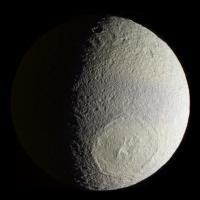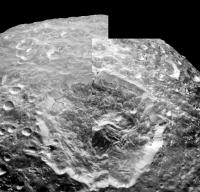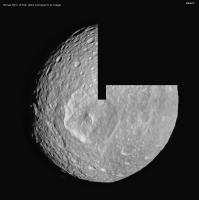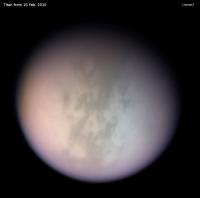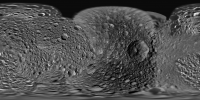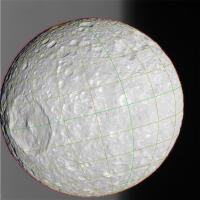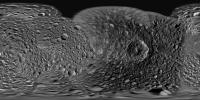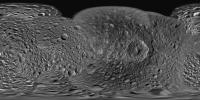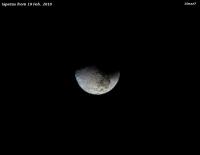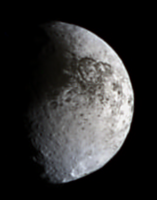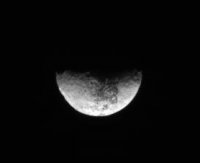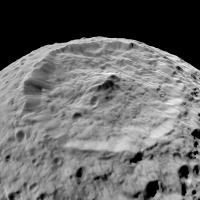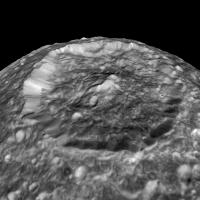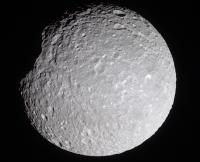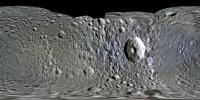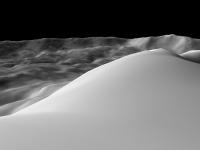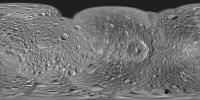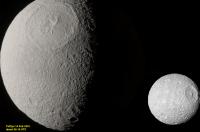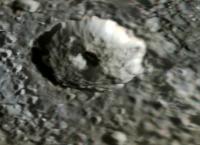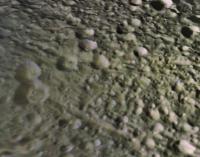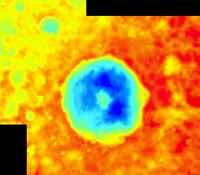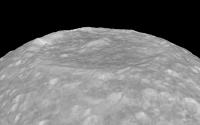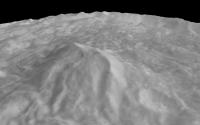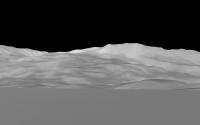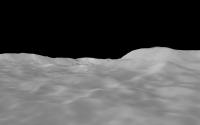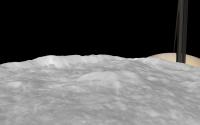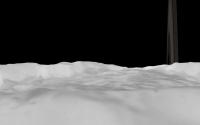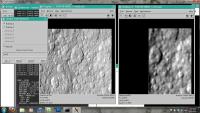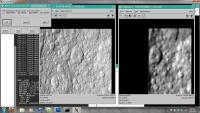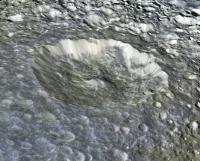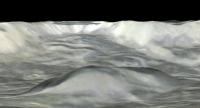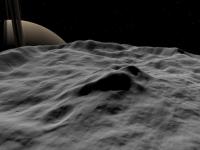Printable Version of Topic
Click here to view this topic in its original format
Unmanned Spaceflight.com _ Cassini's ongoing mission and raw images _ Rev 126 - Feb 4-22, 2010 - Mimas (main target), Tethys
Posted by: belleraphon1 Feb 4 2010, 01:35 AM
All
closest look at Mimas ... 30 minutes after periapsis on 02/13/10 at 17:25 UTC
http://ciclops.org/view/6188/Rev126
"Thirty minutes after periapse, ISS will perform a targeted encounter with Saturn's innermost large icy satellite, Mimas. The altitude for this encounter is 9,510 kilometers (5,910 miles) the closest Cassini has ever gotten to this cratered moon. For this encounter, ISS will acquire three mosaics along with another observation where ISS will be riding along with the Composite Infrared Spectrometer (CIRS). ISS' first mosaic of Mimas, GEOLOG001, will start 30 minutes after closest approach when Cassini is 14,800 kilometers (9,200 miles) away from Mimas. GEOLOG001 is a seven-frame, multi-spectral mosaic of the region surrounding the crater Herschel. Herschel, at 130 kilometers (80 miles) across, is the largest impact basin on Mimas, so large that it caused significant amounts of stress on the lithosphere of the small moon and so distinctive that it helped give the satellite the nickname, "The Death Star Moon." These high-resolution observations of the basin will be used to estimate the age of the crater. Scientists will count the number of smaller craters on the basin floor, compared to other regions on Mimas, to set limits on how old the basin can be. The second mosaic, GEOLOG002, will also be a seven-frame, multi-spectral mosaic, this time covering most of the visible surface of Mimas, shown above left. The best resolutions for these two observations will be 87 meters (285 feet) per pixel for GEOLOG001 and 191 meters (626 feet) per pixel GEOLOG002. Next, Cassini will ride-along with a CIRS FP3 temperature map of Mimas' day side, acquiring six narrow-angle-camera images during the scan. Finally, ISS will acquire a full-frame, multispectral observation (GLOCOL001) of Mimas' anti-Saturn hemisphere from a distance of 70,000 kilometers (44,000 miles). Saturn will provide a backdrop for this observation."
Glorious
Craig
Posted by: volcanopele Feb 4 2010, 03:16 AM
Don't forget poor little Calypso.
Posted by: jasedm Feb 7 2010, 08:08 AM
Yes, I'm glad that Calypso is getting a closer inspection on this rev - it'll be interesting to see how subdued the craters are compared to it's sibling Lagrange moon Telesto
This will mean that everything bigger than a kilometre or so within Hyperion's orbit will have been imaged by Cassini from less than 75,000km, except for Pan, Daphnis, Anthe and Methone - quite an achievement in itself.
Really looking forward to Mimas - I wonder if there'll be more visible faulting around Herschel at the higher resolution?
Posted by: DrShank Feb 10 2010, 06:25 PM
waiting in a snowstorm in DC to see if my train will depart on schedule . . .
Just posted some background info, data, and mosaics related to the upcoming Mimas encounter, including a rotating Mimas movie with the latest global mosaic, on my blog. (the movie is too large to upload here)
http://stereomoons.blogspot.com/
http://www.youtube.com/watch?v=CwWBZFIBkr0
enjoy!
Posted by: belleraphon1 Feb 12 2010, 10:53 PM
Very Cool Dr. Shank!!
I cannot wait!
Thanks.
Craig
Posted by: scalbers Feb 13 2010, 03:27 PM
Nice to see Dr. Shank's color map update. Here is my latest (in B&W) for comparison:
Posted by: scalbers Feb 13 2010, 04:58 PM
Here's a little movie... mimas9.avi ( 835.5K )
: 540
mimas9.avi ( 835.5K )
: 540
Near closest approach (WAC FOV) at 1713UTC
View around 1750UTC - looks more elliptical again
"Live" Herschel NAC field of view at 1814UTC
Posted by: peter59 Feb 13 2010, 05:52 PM
Thanks
Posted by: Hungry4info Feb 13 2010, 07:12 PM
Very much looking forward to images!
Posted by: peter59 Feb 14 2010, 10:09 AM
Calypso !
http://saturn.jpl.nasa.gov/multimedia/images/raw/casJPGFullS57/N00151487.jpg
http://saturn.jpl.nasa.gov/multimedia/images/raw/casJPGFullS57/N00151500.jpg
![]()
Posted by: volcanopele Feb 14 2010, 10:18 AM
Just an FYI: the play back earlier was a short one, only running 2 hrs 20 mins. So we only managed to play back some of the data acquired during the periapse period, like the Calypso images and some images acquired of Saturn's haze layers while Cassini was in the planet's shadow. There is another playback period tonight and that one is the normal, 9 hours long. The Mimas data were carried over to that one.
Posted by: ugordan Feb 14 2010, 10:45 AM
Eclipse view from Feb 13, WAC RGB:
Hmm, the more I look at this, the more it seems I've got it upside down. The rings look as if it's their unlit side, but their shadow should definitely not fall onto Saturn's northern hemisphere. Perhaps it's just the low illumination making this high phase view look unlit. Hence Cassini being above the ring plane and looking "down" onto the rings.
Edit #2: Yep, it's upside down. The parallax motion is only consistent with Cassini orbiting prograde if the image is rotated. Here's the correct orientation and some brightness/saturation enhancement.
Posted by: Astro0 Feb 14 2010, 12:08 PM
Wow, Calypso looks like a neat little place ![]()
Quick animation.
Posted by: Adam Hurcewicz Feb 14 2010, 12:55 PM
I stack to color image ![]() from this:
from this:
N00151479 ( R )
N00151479 ( G )
N00151478 ( B )
Posted by: Ian R Feb 14 2010, 01:20 PM
Here's my version of the Calypso flyby:
http://www.flickr.com/photos/10795027@N08/4355548039/sizes/o/
Posted by: ugordan Feb 14 2010, 01:31 PM
Nice work, Ian!
Reminds me of Telesto, but the surface doesn't appear to be as smooth.
Posted by: jasedm Feb 14 2010, 03:23 PM
Some pretty smooth areas at this resolution - it reminds me of Tempel 1 - infilled small craters, and large areas of very smooth terrain.
Posted by: Floyd Feb 14 2010, 03:36 PM
Adam--Welcome to UMSF! Nice color image--very crisp. I look forward to seeing your work on more images in the future.
Posted by: nprev Feb 14 2010, 03:38 PM
Seems like almost every 'rock' in the Saturn system is pretty much covered with external 'snow'. (Sorry for all the 'quotes'! ![]() ) I assume most if not all of this is coming from Enceladus & not the rings; wonder if this tells us anything about the duration of Enceladus' eruptive activity.
) I assume most if not all of this is coming from Enceladus & not the rings; wonder if this tells us anything about the duration of Enceladus' eruptive activity.
Posted by: Floyd Feb 14 2010, 04:11 PM
This look at Calypso was from 21,257 km at closest approach--we get 5 more looks from under 50,000 km:
Aug 13 2010 22,867 km phase 87 deg inbound
Sep 23 2010 39,359 km phase 87 deg outbound
Mar 10 2012 43,307 km phase 62 deg outbound
Apr 14 2012 49,523 km phase 61 deg inbound
Sep 30 2015 36,251 km phase 72 deg inbound
volcanopele or anyone who can answer:
For non targeted flybys listed on http://www.mpi-hd.mpg.de/cassini/xxm/SM-7/SM-7_all.txt, what percent will actually be used for imaging? I know sometimes other activities have higher priorities. My question is not for every (nt) on the list, but in general and for the 5 encounters listed above.
Edit: Wow these images get out fast. Wikipedia entry on http://en.wikipedia.org/wiki/Calypso_(moon) is updated with yesterday's image.
Posted by: scalbers Feb 14 2010, 04:38 PM
While we're waiting for Mimas images here are some improved movies made using Celestia. The wider angle one is almost the WAC field of view and the other one is about the NAC FOV. In the NAC one we can see Saturn and some other moons go by as Mimas recedes.
http://www.flickr.com/photos/47608252@N08/
Posted by: Ian R Feb 14 2010, 04:48 PM
Thanks Gordan
http://www.youtube.com/watch?v=OGbx7_GHXfw
Posted by: scalbers Feb 14 2010, 04:55 PM
Nice 3D effect with Calypso, almost looks like we're holding one of those cardboard models and spinning it around ![]()
Posted by: ElkGroveDan Feb 14 2010, 05:40 PM
I guess I didn't get up early enough. Here's my belated version of calypso
Posted by: Greg Hullender Feb 14 2010, 05:42 PM
Why does it wobble back and forth repeatedly? Is it just showing the same sequence three or four times?
--Greg
Posted by: Ian R Feb 14 2010, 06:04 PM
Yes, it's the same sequence of images bouncing forwards and backwards; repeated four times. I prefer this sort of presentation as it allows (in my opinion, anyway) for a better appreciation of the three-dimensional shape of the moon, and is less jarring than a standard 'forward-only' animation.
Posted by: Explorer1 Feb 14 2010, 08:47 PM
Is it just my imagination, or are there thin parallel lines near the right side limb? What could be causing them?
Posted by: volcanopele Feb 14 2010, 08:51 PM
Nope, you're not crazy. I was starting to wonder when someone bring up the neatest thing about Calypso...
Posted by: Explorer1 Feb 14 2010, 09:03 PM
I guess over half a decade of lurking on this forum has honed my observation skills.
Posted by: elakdawalla Feb 14 2010, 10:30 PM
Coolness! And good eyes, Explorer1. I noticed those too ![]() Given that there's evidence for landsliding-type motion on other small worlds like Itokawa and Eros, I'd speculate wildly that's what we're looking at -- some kind of flow of the surface fluff toward local gravity lows, possibly induced by the vibration from small impacts.
Given that there's evidence for landsliding-type motion on other small worlds like Itokawa and Eros, I'd speculate wildly that's what we're looking at -- some kind of flow of the surface fluff toward local gravity lows, possibly induced by the vibration from small impacts.
Neat neat neat!
Emily
Posted by: Explorer1 Feb 14 2010, 10:55 PM
So when is the Mimas image down-link? This is the best view we'll get of Mimas for a long time to come, right? The suspense is just.... ugh! ![]()
Posted by: imipak Feb 14 2010, 11:04 PM
I know; isn't it brilliant? Anticipation's half the fun! Every encounter is like a mini launch, orbit insertion or EDL ![]()
Posted by: Stu Feb 14 2010, 11:24 PM
(Obi Wan Kenobi voice on) Patience, young Explorer... impatience leads to anger, anger leads to hate, hate leads to... well, not a very nice place at all... (voice off)
Seriously, just enjoy it. We're spoiled rotten nowadays, and checking again and again to see if new images are up is all part of the excitement.
Posted by: volcanopele Feb 14 2010, 11:31 PM
Tomorrow 5:30am MST/12:30pm UTC, +/- 2 hours
Posted by: vikingmars Feb 15 2010, 11:05 AM
![]() I just like very much this oval moon (Cassini pic from Sept 2009). Enjoy !
I just like very much this oval moon (Cassini pic from Sept 2009). Enjoy ! ![]()
Posted by: tedstryk Feb 15 2010, 11:41 AM
Here we are!!!
http://saturn.jpl.nasa.gov/photos/raw/rawimagedetails/index.cfm?imageID=213591
http://saturn.jpl.nasa.gov/photos/raw/rawimagedetails/index.cfm?imageID=213654
http://saturn.jpl.nasa.gov/photos/raw/rawimagedetails/index.cfm?imageID=213598
Posted by: ugordan Feb 15 2010, 12:16 PM
Check out that darkening creeping up the crater walls! It's looks like sediment left over from liquid evaporation.
Posted by: peter59 Feb 15 2010, 12:18 PM
Damn, the best picture is a bit overexposed. ![]()
http://saturn.jpl.nasa.gov/multimedia/images/raw/casJPGFullS57/N00151520.jpg
Posted by: Stu Feb 15 2010, 12:19 PM
Wow...
http://saturn.jpl.nasa.gov/multimedia/images/raw/casJPGFullS57/N00151591.jpg
Posted by: ugordan Feb 15 2010, 12:24 PM
I don't think it's overexposed. More looks like the effect of very low phase on brightness and contrast. Also, who knows what the raw contrast stretch did here.
Posted by: Bjorn Jonsson Feb 15 2010, 12:25 PM
http://saturn.jpl.nasa.gov/photos/raw/rawimagedetails/index.cfm?imageID=213591
http://saturn.jpl.nasa.gov/photos/raw/rawimagedetails/index.cfm?imageID=213654
http://saturn.jpl.nasa.gov/photos/raw/rawimagedetails/index.cfm?imageID=213598
The last one is obviously Herschel. Very few craters on Herschel's floor and all of them are small. I expected to see some landslides on the crater rim's inside but there are none (or at least no big ones). One thing to keep in mind: The images are heavily contrast stretched because Mimas more than fills the field of view - no black space is visible. So I suspect that what's black in this image really isn't in black (in shadow).
There are some WA context images, for example this one:
http://saturn.jpl.nasa.gov/photos/raw/rawimagedetails/index.cfm?imageID=213720
A nice NA global image:
http://saturn.jpl.nasa.gov/photos/raw/rawimagedetails/index.cfm?imageID=213675
A closeup of Herschel with some black space visible - the contrast stretch doesn't mess things up completely in that case:
http://saturn.jpl.nasa.gov/photos/raw/rawimagedetails/index.cfm?imageID=213654
Mimas' rough and uneven limb:
http://saturn.jpl.nasa.gov/photos/raw/rawimagedetails/index.cfm?imageID=213606
Should be plenty of images for a nice stereo-derived DEM of Herschel
Posted by: volcanopele Feb 15 2010, 12:26 PM
http://saturn.jpl.nasa.gov/multimedia/images/raw/casJPGFullS57/N00151591.jpg
Here is an even better version
http://saturn.jpl.nasa.gov/photos/raw/rawimagedetails/index.cfm?imageID=213678
Posted by: Bjorn Jonsson Feb 15 2010, 12:30 PM
The image is heavily contrast stretched since no black space is visible so I think the darkening is only slightly darker than the stuff above it. Still very interesting.
EDIT: From the image someone said was overexposed I now see the contrast is higher than I expected (I'm looking at the images as I type
Posted by: Stu Feb 15 2010, 12:30 PM
... or, to put it another way...
WOOHOO!!!! New pictures of Mimas! And we can drool over them just a day or so after they were taken!!! How lucky are we?!?!?!?
Stunning pics, Cassini just keeps delivering, doesn't she?
Posted by: Floyd Feb 15 2010, 12:34 PM
Wow, what a great set of images, including Epimetheus and Janus playing http://saturn.jpl.nasa.gov/multimedia/images/raw/casJPGFullS57/N00151618.jpg. Very exciting to be on the Cassini site as the boxes with red X's turn to impossibly great images.
Posted by: ugordan Feb 15 2010, 12:37 PM
I'm guessing low albedo variations show up so clearly because of the low phase angle here.
Posted by: charborob Feb 15 2010, 02:01 PM
http://saturn.jpl.nasa.gov/multimedia/images/raw/casJPGFullS57/N00151520.jpg
Modifying levels and curves on this image in Pshop, I get this:
There seems to be ridges (outcrops?) on the central peak of Herschel.
Posted by: volcanopele Feb 15 2010, 02:14 PM
Four of the images from the encounter are highlighted on the CICLOPS website:
http://ciclops.org/view_event/128/Mimas_Rev_126_Flyby_Raw_Preview
Posted by: angel1801 Feb 15 2010, 03:06 PM
There is also a set of Tethys images from about 177,000km available too.
Posted by: Juramike Feb 15 2010, 03:17 PM
Tethys images up: http://saturn.jpl.nasa.gov/multimedia/images/raw/casJPGFullS57/N00151608.jpg
[EDIT: see below]
Posted by: Poolio Feb 15 2010, 03:57 PM
Nice one, charborob. The darkening in the crater walls is really pronounced in that image. Gordon's interpretation is enticing; I look forward to hearing other possibilities.
Kudos once again to the Cassini team for the spectacular views of another world. What amazing times we live in.
Posted by: ugordan Feb 15 2010, 04:01 PM
I made no interpretation, just said what it looks like
Posted by: dilo Feb 15 2010, 04:07 PM
Merging N00151591+93+95 (green+IR2+UV2 filters respectively in place of G,R,B channels) with Saturn in background:
This is a enhanced version:
Posted by: volcanopele Feb 15 2010, 04:14 PM
Bah! Just when I though I got my color version done before you guys. Curses!
![]()
![]()
![]()
Posted by: dilo Feb 15 2010, 04:21 PM
I would like to see your version, for sure is different (at least in terms of alignment technique, which was difficult for me...)
Posted by: belleraphon1 Feb 15 2010, 04:54 PM
Wonderful as always.
Yeah, Stu, the fact we get access to these images so quickly still boggles this old space hound.
What is really amazing to me is that we have this old, battered moon (on the surface) riding right next to the most active mid-sized moon Enceladus.
Location in a system does not necessarily tell the whole story?!
Craig
Posted by: Adam Hurcewicz Feb 15 2010, 05:02 PM
Janus and Epimetheus eclipses (animation)
Posted by: ElkGroveDan Feb 15 2010, 05:13 PM
Well since Adam beat me by a few seconds, here's a MOV file instead
Posted by: dilo Feb 15 2010, 05:59 PM
Feb, 14 sequence animation:
Note the curious sudden illumination change on Epimtheus from a body on the right, perhaps from Janus itself (strange geometry, however)
Posted by: ugordan Feb 15 2010, 06:33 PM
Looks like "sunset" to me.
Posted by: volcanopele Feb 15 2010, 06:37 PM
Nice catch about the change in illumination on Epimetheus. I doubt it is from Janus since that moon is clearly on the OTHER side of Epimetheus from those craters. I think we are just seeing a slight bit of rotation on Epimetheus, and the Sun is setting on the far rims of three impact craters just beyond the evening terminator.
I have to admit that I started to doubt that explanation since I suddenly thought that north might be up, so the terminator we are seeing would be the dawn one... But nope, south is up in your animation, so my explanation holds...
Posted by: belleraphon1 Feb 15 2010, 07:16 PM
I do not usually throw in attachments so bare with me...
But in this Mimas image I am not convinced all the low albedo stuff is due to shadow.
It is from NAC image N00151508. Also if you look at dilo's colorized global image you can see a few darkish spots in the high phase region. Kinda like the Rhea ring impactors but more dispersed (not in a line)?
Interesting.
Craig
Posted by: Explorer1 Feb 15 2010, 07:45 PM
Wow this stuff is truly great. Honestly if it wasn't for the central peak Herschel almost looks like it formed some other way. It's just so irregular and different from other big craters, like on the moon or Callisto.
Mysteries abound!
Posted by: Juramike Feb 15 2010, 07:50 PM
Compare it to Rhea. Many of the larger craters on that moon are also irregular.
Mass wasting and slumping the crater walls of Herschel seem evident.
EDIT: Looking at the picture that Craig posted it seems that there is a tendency for the walls to form and slump along parallel lines going from lower left to top right.
Posted by: Ian R Feb 15 2010, 08:01 PM
Here are my two 'bouncy' animations of this mutual event:
Epimetheus-centric: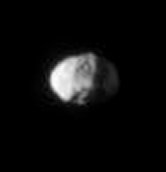
Janus-centric:
Posted by: Adam Hurcewicz Feb 15 2010, 08:19 PM
- Full quote deleted. Use the "add reply" button at the bottom of the page. -
Nice work !
Your animations show rotations of this monns
Posted by: dilo Feb 15 2010, 08:56 PM
Grat animations, Ian! (original quality is clearly better than mine...)
Gordan, you were right!
Posted by: Adam Hurcewicz Feb 15 2010, 09:06 PM
TETHYS in (IR1, G UV3)
ir1 N00151608
g N00151607
uv3 N00151606
Posted by: Poolio Feb 15 2010, 09:08 PM
What we're seeing here is these two co-orbitals exchanging orbits, correct? It seems natural to think that the switching of orbits would need to cause temporary redirections of the moons from their normal elliptical orbits, and therefore the observed rotations and exposure of hidden surfaces to the sun.
Posted by: Floyd Feb 15 2010, 09:23 PM
I'm not exactly sure where they are in the process of exchanging orbits, but I think the relative movement we see here is mainly the changing perspective of Cassini as it rushes by.
Posted by: Phil Stooke Feb 15 2010, 09:34 PM
This is not the orbital switch. There are several factors - the moving spacecraft, the moons moving relative to the sun and to each other.
Phil
Posted by: Poolio Feb 15 2010, 09:37 PM
But changing the observer's perspective couldn't account for the change in illumination of the subject. We must be seeing physical rotation of the moons themselves relative to the sun.
Posted by: Phil Stooke Feb 15 2010, 09:38 PM
"in this Mimas image I am not convinced all the low albedo stuff is due to shadow."
These patches don't look unusually dark in images with more overhead lighting, which you can see further up the thread. - but there are real dark spots in places further east.
Phil
Posted by: volcanopele Feb 15 2010, 09:46 PM
Yes, exactly. These movies are taken over a non-insignificant fraction of the day for these moons. But it doesn't have to do with any interaction between the two moons.
Posted by: Poolio Feb 15 2010, 09:58 PM
Okay, I get it. Thanks. So the rotation we're seeing is just the normal rotation of these moons. "Sunset", like Gordon said about 10 posts ago.
(I should know better than to post before doing my homework. The switching of orbits happened on http://ciclops.org/view/6102/Rev124, more than three weeks ago.)
Posted by: Adam Hurcewicz Feb 15 2010, 10:30 PM
I finish colorize MIMAS. This dark areas are more visible.
ir2 N00151593
BL1 N00151591 (like chanel G)
uv2 N00151595
Posted by: tedstryk Feb 15 2010, 10:51 PM
Adam, it says "Limax 7" in the corner of your images. What does that mean?
Posted by: Adam Hurcewicz Feb 15 2010, 11:07 PM
It's my nick in polish forums: astro4u and astro-forum.org (the largest polish astro forums)
but also I use this nick in other groups: comet-ml
Posted by: Juramike Feb 16 2010, 02:17 AM
Final adjusted color composite RGB [IR1, GRN, UV3], with enhancement in the overexposed region:
The ridge at the limb to the upper right of Odysseus is likely a remnant of another large impact basin.
Full res here: http://www.flickr.com/photos/31678681@N07/4361319512/
Posted by: peter59 Feb 16 2010, 07:58 AM
My mosaic is not of good quality, I hope that someone will do it better, but the view is impressive.
Posted by: ElkGroveDan Feb 16 2010, 08:01 AM
It's underexposed.
Posted by: remcook Feb 16 2010, 08:50 AM
Nice 'little' storm:
http://saturn.jpl.nasa.gov/photos/raw/rawimagedetails/index.cfm?imageID=213757
Posted by: ugordan Feb 16 2010, 10:11 AM
Too contrast-stretched would be a better description.
Posted by: Adam Hurcewicz Feb 17 2010, 01:14 PM
And my Mimas mosaic from 4 images:
N00151557.jpg
N00151553.jpg
N00151577.jpg
N00151578.jpg
Posted by: Adam Hurcewicz Feb 18 2010, 08:44 AM
Color Titan image from 16 Feb. 2010
I use images:
RED and CL2 filters: http://saturn.jpl.nasa.gov/multimedia/images/raw/casJPGFullS57/N00151632.jpg
CL1 and GRN filters: http://saturn.jpl.nasa.gov/multimedia/images/raw/casJPGFullS57/N00151634.jpg
BL1 and CL2 filters: http://saturn.jpl.nasa.gov/multimedia/images/raw/casJPGFullS57/N00151633.jpg
CL1 and CB3 filters: http://saturn.jpl.nasa.gov/multimedia/images/raw/casJPGFullS57/N00151636.jpg
FINAL image:
Posted by: scalbers Feb 19 2010, 04:06 PM
N00151557.jpg
N00151553.jpg
N00151577.jpg
N00151578.jpg
Nice to see this moderately high resolution mosaic. Maybe advantageous for mapping.
Posted by: CAP-Team Feb 19 2010, 06:37 PM
I had already checked your site for a map update ![]()
Posted by: volcanopele Feb 19 2010, 07:29 PM
I already tried updating my copy of Steve's map ![]() Steve, what size did you use for Mimas? Did you assume a spherical Mimas? I converted my mosaic to a simple cylindrical map and I can't get things to line up.
Steve, what size did you use for Mimas? Did you assume a spherical Mimas? I converted my mosaic to a simple cylindrical map and I can't get things to line up.
Posted by: scalbers Feb 19 2010, 10:43 PM
CAP-Team - my first step in updating the map is using a more full disk low-phase image as can be seen here:
VP - I'm using these three triaxial dimensions: 414.8 394.4 381.4. Good question about the fit as Mimas is a great test of our handling of triaxial ellipsoids. Here is a look at the degree of fit (and size relative to the limb) with the image I'm using:
How nice to have Saturn backlighting & highlighting the dark limb, right where this is needed
Steve
Posted by: volcanopele Feb 19 2010, 11:48 PM
Well, the issue that I have is that my Herschel comes out looking oblong in the north-south direction, which I think it should..., but it pushes some of the craters north and south of Herschel closer to the poles than what is shown in the map on your website.
Posted by: Phil Stooke Feb 20 2010, 01:19 AM
Sounds like the dreaded Peters Projection! Seriously, is it a map projection mismatch?
Phil
Posted by: scalbers Feb 20 2010, 02:44 PM
Perhaps VP is working with a planetographic map as I think that corresponds with an oblong appearance for Herschel. The official maps on the CICLOPS site also appear to be planetographic. Conversely I am working with planetocentric coordinates (still on the triaxial ellipsoid), where Hershel should probably look more round.
It appears possible to convert between planetocentric and planetographic. One way (at least for the latitude part) might be the reverse of what is discussed below:
https://isis.astrogeology.usgs.gov/IsisSupport/index.php?topic=1550.0
Here BTW is a map using three images from the new flyby.
Steve
P.S. I recall running into the Peters projection on another project, thankfully not this one!
Posted by: Bjorn Jonsson Feb 20 2010, 08:23 PM
Looks great even though the contrast stretch is a bit extreme for my taste (completely black shadows in craters etc.). Is the automatic contrast stretch applied to the source images one of the reasons for this?
Posted by: scalbers Feb 20 2010, 08:32 PM
Bjorn - yes it's true this looks quite a bit more contrasty and darker compared with say my Enceladus map. For Mimas many of the first images on the map were at higher phase angles. That coupled with such a battered surface tended to give a preponderance of shadowed craters. This kind of became the norm for contrast when newer images are added. New images at low phase thus have to be contrast stretched quite a bit to look consistent. Nonetheless it appears to be a good suggestion and I will try to soften the shadows (and avoid losing details) with some of the imagery.
Here's a slightly less contrasty 4K version:
Steve
Posted by: Adam Hurcewicz Feb 20 2010, 09:31 PM
Steve, what software you use to making maps? I searched Google and nothing..
Posted by: scalbers Feb 20 2010, 10:15 PM
Adam - I'm using IDL. Using this software I wrote various procedures that help me navigate images, handle the map projections, and do the mapping.
Steve
Posted by: Adam Hurcewicz Feb 21 2010, 02:15 PM
Iapetus color image (19 Feb. 2010)
N00151720.jpg ®
N00151716.jpg (G)
N00151719.jpg (![]()
Posted by: elakdawalla Feb 21 2010, 09:48 PM
Nice! Here's my version ![]() Used all the images, stacked to attempt to reduce JPEG artifacts, enlarged 200%.
Used all the images, stacked to attempt to reduce JPEG artifacts, enlarged 200%.
Posted by: Adam Hurcewicz Feb 22 2010, 02:25 PM
Here is Iapetus animation from 4 images:
http://saturn.jpl.nasa.gov/photos/raw/rawimagedetails/index.cfm?imageID=213904
http://saturn.jpl.nasa.gov/multimedia/images/raw/casJPGFullS57/N00151741.jpg
http://saturn.jpl.nasa.gov/photos/raw/rawimagedetails/index.cfm?imageID=213887
http://saturn.jpl.nasa.gov/multimedia/images/raw/casJPGFullS57/N00151724.jpg
http://saturn.jpl.nasa.gov/photos/raw/rawimagedetails/index.cfm?imageID=213862
http://saturn.jpl.nasa.gov/multimedia/images/raw/casJPGFullS57/N00151699.jpg
http://saturn.jpl.nasa.gov/photos/raw/rawimagedetails/index.cfm?imageID=213833
http://saturn.jpl.nasa.gov/multimedia/images/raw/casJPGFullS57/N00151670.jpg
Posted by: Bjorn Jonsson Feb 24 2010, 12:01 AM
Using Steve's updated map of Mimas I made a quick and dirty shape from shading (SFS) DEM and combined it with my earlier DEM of Mimas created using stereo imagery (see http://www.unmannedspaceflight.com/index.php?showtopic=6465 for more information on these 'combined DEMs'). The stereo DEM itself hasn't been updated with the new data (I don't expect to update it until this data hits the PDS) so the resulting stereo+SFS DEM is not accurate - this is a test render:
This image has a field of view of 45° and the altitude above the surface is ~125 km. There is some longitudinal striping that I managed to partially hide by carefully selecting the light source location. I'm using a uniform white map for a texture map so all of the details come from the DEM.
Posted by: elakdawalla Feb 24 2010, 12:42 AM
Bjorn, it's very hard to mosaic the Mimas images because Cassini was moving so fast that the perspective shifted markedly from frame to frame. But "official" mosaics are also lacking because when they reproject the images they do so onto an ellipsoid, which destroys limb topography in the resulting mosaic. Will your DEM of Mimas eventually enable you to reproject Cassini images onto an appropriately lumpy body, producing Mimas "mosaics" (maybe should call them "rendered mosaics") that have proper limb topography?
Posted by: Bjorn Jonsson Feb 24 2010, 01:08 AM
Yes, the DEM enables this and the accuracy of the resulting images/"mosaics" depends solely on the accuracy of the DEM. An annoying problem/artifact is the east-west striping and in this case the stereo DEM also is very crude as previously noted. Here is a test render where Steve's map has been draped over the DEM without applying any shading:
The viewing geometry is the same as previously. This reveals that some of the DEM's topography may be due to albedo variations in the source map and not due to topographic shading. 'Blinking' these two images is rather interesting.
Posted by: Exploitcorporations Feb 24 2010, 06:26 AM
Always so much to catch up on...fantastic DEM perspectives, Bjorn. That's a scene I've had in my imagination for ages, finally made real. Your map is beautiful as always, Steve. I'd like to suggest possibly using images from the 28 June 2007 pass for detail west of Herschel and the transition to the coverage from August 2005. The fine fractures and/or crater chains show up much better, and it seems to beat the resolution of the partial Voyager coverage. I'm reposting Gordan's excellent color version for reference. You're all awesome. Belated welcome to Adam too!
ugordan's Mimas 28/06/07:
Posted by: 2of7 Feb 25 2010, 12:31 PM
Hi everyone! This is my first post: usually I read but I don't write (I'm a bit slow to write in English!!! ![]() ).
).
Of all the missions in progress, I follow with particular interest the Cassini mission.
On February 13, 2010, Cassini flew by Saturn's moon Mimas, coming as close as 9.500 kilometers.
Pending other NASA's images, here some of mine processed for Lunar Explorer Italy:
N00151541-60 MIMAS CL1 and CL2 filter mosaic
http://www.flickr.com/photos/lunexit/4362422472/
http://www.flickr.com/photos/lunexit/4362422472/
Herschel Crater (IR1, GRB, UV filter)
http://www.flickr.com/photos/lunexit/4361704219/sizes/o/
http://www.flickr.com/photos/lunexit/4361704219/sizes/o/
Mimas in front of Saturn - False and natural color
http://www.flickr.com/photos/lunexit/4361885853/sizes/o/
http://www.flickr.com/photos/lunexit/4361885853/sizes/o/
Posted by: Floyd Feb 25 2010, 01:25 PM
2of7 Welcome to UMSF. Maybe a benevolent admin can move your post and nice images from the closed thread to this one. Unlike many forums in which almost every new post is a new thread, at UMSF most posts here go into ongoing threads. I hope you are undaunted by the outcome of your first post and continue to contribute images.
Posted by: 2of7 Feb 25 2010, 01:51 PM
Thanks Floyd. My mistake! I saw the right category but in the end I wrong!
All this, will be the fault of my English! ![]() I'm sorry... if some admin'll move the images here I would be happy
I'm sorry... if some admin'll move the images here I would be happy ![]()
Posted by: Juramike Feb 25 2010, 02:32 PM
Welcome to UMSF, 2of7!
![]()
Posted by: 2of7 Feb 25 2010, 02:43 PM
thanks to the admins to have moved my post!
Hi Juramike, we wrote on flickr ... and now I am here! : )
Posted by: DrShank Feb 25 2010, 05:02 PM
here is the global color and high-resolution map of Mimas i posted on my blog a few weeks back!
(although at 400 m resolution, this version is shown at 800 m). I will be posting some fun Rhea views later today.
The paper describing all the color maps has now been submitted for publication. In it we describe
the blue equatorial bands on the leading hemispheres of both Mimas and Tethys and show
they are due to electrons bombarding and altering the surface. The Saturn system is complicated!
http://stereomoons.blogspot.com
Posted by: 2of7 Feb 25 2010, 05:06 PM
Mimas and Tethys crater:
http://www.flickr.com/photos/lunexit/4367259591/sizes/o/
http://www.flickr.com/photos/lunexit/4367259591/sizes/o/
....so similar and different at the same time!
Posted by: Bjorn Jonsson Feb 26 2010, 08:16 PM
Here is a Mimas/Herschel animation based on a slightly improved version of the DEM mentioned earlier in the thread. Steve's map has been draped over the DEM: mimas_herschel_stereo_sfs_dem.avi ( 4.86MB )
: 358
mimas_herschel_stereo_sfs_dem.avi ( 4.86MB )
: 358
The field of view is 50° and the altitude above Mimas' surface ranges from ~100 km to ~250 km. As mentioned earlier the stereo based DEM is extremely crude since I haven't incorporated the new data into it. Once this data hits the PDS the accuracy will greatly improve. It should also be kept in mind that the shape-from-shading DEM I combined with the stereo DEM is highly preliminary. Despite this I think this gives a good idea of what this thing looks like - at the very least this is by far the most realistic animation of Herschel I have ever seen ;-).
Posted by: stevesliva Feb 27 2010, 12:35 AM
Nice! The view from that peak would be tremendous.
Posted by: Bjorn Jonsson Feb 28 2010, 12:39 AM
The view to the NNW from the central peak summit might be somewhat similar to this:
The altitude above the central peak summit is less than 100 meters and the field of view is 60 degrees. Needless to say the detailed appearance of the crater floor is only approximate but the crater wall height should be fairly accurate.
Posted by: Antdoghalo Feb 28 2010, 01:36 AM
http://www.flickr.com/photos/lunexit/4367259591/sizes/o/
http://www.flickr.com/photos/lunexit/4367259591/sizes/o/
....so similar and different at the same time!
Those are no moons
Those are the Death stars we thought we blew up
Wheres George Lucas when you need him
Posted by: stevesliva Feb 28 2010, 03:08 PM
Cool! Too bad it's the anti-saturn hemisphere...
Posted by: scalbers Feb 28 2010, 03:19 PM
The viewing geometry is the same as previously. This reveals that some of the DEM's topography may be due to albedo variations in the source map and not due to topographic shading. 'Blinking' these two images is rather interesting.
Bjorn - nice to see the layering in the walls of Herschel on this. Is this a true vertical perspective or is there any vertical exaggeration?
Posted by: scalbers Feb 28 2010, 03:28 PM
(although at 400 m resolution, this version is shown at 800 m). I will be posting some fun Rhea views later today.
The paper describing all the color maps has now been submitted for publication. In it we describe
the blue equatorial bands on the leading hemispheres of both Mimas and Tethys and show
they are due to electrons bombarding and altering the surface. The Saturn system is complicated!
http://stereomoons.blogspot.com
Interesting Paul to see this blue band on both Mimas and Tethys. I also notice they both show a brownish color on their trailing hemispheres.
Posted by: Bjorn Jonsson Feb 28 2010, 04:09 PM
There is no vertical exaggeration in any of the images/animations I have posted here. The largest uncertainty is the steepness of the crater walls. This is because the stereo DEM is very crude as previously noted.
Posted by: Juramike Feb 28 2010, 04:28 PM
What is the blue color from? I seem to recall reading somewhere that energetic particles could create and trap oxygen radicals in water ices.
Posted by: scalbers Feb 28 2010, 09:21 PM
Greetings Exploit, Good eyes - that's a great idea about using the June 28, 2007 data. ugordan's image works nicely for this. Below is how the map looks with this image included. The overall brightness is turned up now so less detail gets lost in the shadows.
Just for fun I'll point out the new image is *east* of Herschel. Remember that movie, Krakatoa, East of Java?
That's the latest,
Steve
Posted by: hendric Mar 1 2010, 04:47 PM
Can someone create a comparison of Mimas and Tethys with the same size scale for both? Would be funny to see the big and baby death star at the same time.
Posted by: Floyd Mar 1 2010, 09:28 PM
See post 96 in this thread ![]()
Posted by: hendric Mar 1 2010, 09:42 PM
Floyd,
I was hoping for a montage with the same scale used for both pictures.
Posted by: Exploitcorporations Mar 2 2010, 06:44 AM
Just for fun I'll point out the new image is *east* of Herschel. Remember that movie, Krakatoa, East of Java?
Facepalm. Your OTHER west. The map looks great, much smoother! Thanks for considering my suggestion. I haven't seen the movie, but I see Maximillian Schnell from "The Black Hole" is in it. There is no east or west beyond the singularity, is there?
Bjorn: I can't use the adjectives I want to here to compliment that animation. Hendric: If no one beats me to it, I have a very large scale-comparison series in the works. Just waiting for Helene.
Posted by: centsworth_II Mar 2 2010, 09:30 AM
Based on the dimensions in http://www.windows.ucar.edu/tour/link=/saturn/moons_and_rings.html&edu=high I reduced the image of Mimas to about 38.5% of its original size to get this approximation of relative sizes.
Posted by: DrShank Mar 2 2010, 01:55 PM
I thought Id throw in my Herschel rendering, even tho it is based only on 4 year old lower resolution data (I am expressly forbidden from using any data less than one year old). I also include a view of cratered highlands. These views do not include the curvature of the sphere, which would be rather pronounced of course!
Posted by: Gladstoner Mar 4 2010, 02:45 AM
.
Posted by: volcanopele Mar 4 2010, 03:28 AM
These seem to be more related to the gravity fields of these little moons, i.e. the grooves suggest movement of loose material toward areas closer to the center of Calypso (or Helene or Telesto).
Posted by: ugordan Mar 29 2010, 07:22 PM
http://www.ciclops.org/view_event/132/Closest_Views_of_Cratered_Mimas
Cassini's recent and closest flyby of Saturn's moon Mimas generated views of this "Death Star" moon in unprecedented detail and a new temperature map of its surface.
Posted by: Explorer1 Mar 29 2010, 07:44 PM
That temperature map is just mystifying. Is it only coincidence that Herschel is right in the middle of the cold spot? Or might it be the cause?
Reminds me of Pac-Man eating a power up!
![]()
Wonderful images anyway!
Posted by: DrShank Mar 29 2010, 09:28 PM
Reminds me of Pac-Man eating a power up!
Wonderful images anyway!
Yes it is very interesting! It is also almost exactly coincident with the blue equatorial band we showed in our Maps of Mimas
in October. We have a good idea about the cause of it but I cant say anything until our paper we submitted to Icarus last
month passed peer review. anyone who knows me knows i hate being coy but Im afraid we have to wait just alittle bit longer
before going public. lets just say its "electrifying" . . .
Posted by: belleraphon1 Mar 29 2010, 10:13 PM
Ain't no such thing as a boring world (worldlet, moon, planet, dwarf planet, etc)
Craig
Posted by: Explorer1 Mar 29 2010, 11:41 PM
Is that a hint?
Looking forward to no matter what!
Posted by: Bjorn Jonsson Jan 25 2011, 08:22 PM
The data discussed earlier in this thread was released at the PDS Imaging Node early this month. Using this data I have now created a far more accurate DEM of Herschel than the one I mentioned earlier in the thread. The DEM is based on stereo imagery.
First a section of the DEM. It is fairly detailed but not flawless. It is slightly 'tilted', resulting in higher elevations east of Herschel than west. The DEM reveals that Herschel has a raised rim and the crater floor is deepest north and southeast of the central peak.
Now I really need to find the time to learn how to correct the camera angles using ISIS (any tips? ![]() ), the result should be a significant improvement in accuracy.
), the result should be a significant improvement in accuracy.
Then some quick and dirty test renders where data from a simple cylindrical map has been draped over the DEM. This map is a byproduct of the DEM creation process (it really is an orthophoto). First an overview of Herschel. The crater floor is obviously fairly flat and not curved:
An overview of the central peak:
The view from the central peak summit looking east:
Looking northeast from a few km above the crater floor, the central peak is visible at right:
The field of view (FOV) in all of these images is 45° except for the last one where it is 50°. They are rendered using true vertical relief in all cases.
I then decided to add Saturn just to see what things look like. Two quick test renders with a 50° FOV. First one looking east from above the western rim:
And looking east over the central peak:
Posted by: volcanopele Jan 25 2011, 08:44 PM
Which version of ISIS are you running? I use ISIS2 and use deltack to fix ISS camera angles. If you use ISIS3... well, umm, there is a reason I still use ISIS2...
Posted by: Bjorn Jonsson Jan 25 2011, 10:07 PM
I haven't been using ISIS a lot (I generated the DEM using software written by myself) but I have used both ISIS2 and ISIS3 a bit - I have both versions on my machine.
Posted by: volcanopele Jan 25 2011, 11:12 PM
Well, I know with ISIS2, you can use deltack to adjust the camera angles by comparing the images to a synthetic image, a basemap, or a previously corrected image, for example. Below are so
If you want to tie the image to a synthetic image (good for full-disk image where you are basically doing an interactive limbfit):
deltack from=W1673418018_1.trim2.cub iline=517 isamp=390 tline=516 tsamp=391 +
ck1to=/data/cassini/perry/Rev143/Rev143.bc
If you want to tie the image to a basemap or previously reprojected image (if you are making a quick mosaic or you are tying color filter image from a single frame):
tfile=N1673418904_1.ctrl.dat
geom from=../../W1673418018_1.orth.cub to=N1673418904_1.ctrl.cub tfile=N1673418904_1.ctrl.dat
deltack from=N1673418904_1.trim2.cub iline=505 isamp=598 tline=497 tsamp=615 +
ck1to=/data/cassini/perry/Rev143/Rev143.bc
To get the number for deltack, you use qview. You first load the image you want to adjust, then the control image (either the synthetic image or the control image from the basemap/other image). Make sure the two images use the same magnification and Link the two images. Also click the check mark next to Register and type in a file name (in the example below, I used ctrl)
Then you blink the two images using the Blink dialog box. You can move the control image around using the move tool (second button from the left). Clicking using the left mouse button at the top of that image will move it down one pixel (multipled by the scale of the image, in this case, 2 pixels), clicking the bottom of the image will move it up 1, clicking the left side will move it to the right by one pixel, click the right side will move it to the left. Clicking in the corners also works, for example clicking in the upper left corner will move the control image down and to the right. You keep shifting the control image around until the two images, blinking in the other window, are lined up as best as you can make it. Once you have that, you move your mouse cursor over to the original image and you press Ctrl+S. This will bring up the Control Point save dialog box.
The numbers in this box are what you put into deltack. In my example, the first number, 458, goes with tline. The second number, 460, goes with tsamp. The third number, 466, goes with iline. Finally, the fourth number, 451, goes with isamp. Click OK then you can run deltack using the command line.
I do this so often, I can honestly do this in my sleep, but that means that it might be difficult for me to clearly explain this to others. If you have any questions, use "help deltack" in TAE for a more detailed explanation and other usage cases.
Posted by: DrShank Jan 26 2011, 12:34 AM
Good work there on Herschel.
See also my posting about high-resolution Herschel topography http://stereomoons.blogspot.com/. Here I do have rectified and registered imagery tied to my global control network. The global DEM is also tied to does indeed show that the floor is deeper to the east and there is an ejecta blanket, among other things. These were described in my LSPC abstract and will be shown there in March. Ive also added the full-res color maps, which are subtle in this rendering.
Now all i need is a tool to render the view on a spherical instead of an infinitely "flat" surface. What do you use?
paul
Posted by: DrShank Mar 14 2011, 03:18 PM
Just posted my http://www.youtube.com/galsat400#p/u/0/YmrzWW8HG5M video to Youtube!
Posted by: Bjorn Jonsson Jun 4 2011, 12:54 AM
I'm resurrecting this discussion because now I'm again working on DEMs of Mimas and Enceladus. Also I had some problems with ISIS earlier where not everything was working properly (in particular qview didn't work) but now everything seems to work perfectly and I have dozens of images where I want to fix the camera pointing.
Have you been using deltack only or have you used jigsaw as well? I get the impression that when I want to mosaic lots of images into an (eventual) map I should probably be using jigsaw but I may be wrong.
tfile=N1673418904_1.ctrl.dat
geom from=../../W1673418018_1.orth.cub to=N1673418904_1.ctrl.cub tfile=N1673418904_1.ctrl.dat
deltack from=N1673418904_1.trim2.cub iline=505 isamp=598 tline=497 tsamp=615 +
ck1to=/data/cassini/perry/Rev143/Rev143.bc
When you say "basemap or previously reprojected image" do you mean something like for example http://www.ciclops.org/view/6197/Map_of_Enceladus_-_February_2010? One reason I ask is that despite the fact that this map is big (14400x7200 pixels) the resolution is remarkably low in my opinion and and there are some black areas (possibly due to a contrast stretch or filtering). This makes accurate measurements difficult in some areas when dealing with hi-res images I want to correct.
Posted by: Bjorn Jonsson Aug 28 2011, 11:47 PM
This is an experimental Herschel animation:
http://www.youtube.com/watch?v=sfCQ7f7PMbc
The DEM is an improved version of my DEM mentioned earlier in the thread. I used ISIS to improve the camera angles and instead of only using a DEM derived from stereo imagery I increased the DEM's resolution by combining two DEMs. One created using stereo imagery (for large scale features) and another one created using shape from shading (SFS; for small scale features). When using SFS care must be taken as it cannot distinguish between intensity variations caused by topography and variations caused by albedo differences. I think the SFS DEM I used is fairly accurate - after comparing the stereo DEM and some Cassini images it seems to me that most of the brightness variations on Herschel's floor are caused by topography.
The final step was to 'cheat' a bit by adding lots of fictional, small craters because at this close range the surface looked too smooth without them. The field of view is 50 degrees and the distance from Mimas' center is constant (228 km) throughout the animation. When rendering this I used a uniformly white texture map, i.e. all of the surface details are coming from the DEM.
Posted by: Roby72 Aug 29 2011, 10:21 PM
Björn, excellent animation !
...I think that the rings of Saturn must be edge on from Mimas, isn it ?
Robert
PS: according Wikipedia Mimas´ inclination is 1.574°
Posted by: Hungry4info Aug 29 2011, 10:23 PM
Mimas has a slightly inclined orbit IIRC.
Posted by: machi Sep 1 2011, 09:49 PM
It looks like movie from Kaguya's HD camera, excellent!
Posted by: Phil Stooke Sep 1 2011, 11:26 PM
Great job! And while looking at it I saw your Amalthea flyby as well - that's great too. I seem to recognize that shape!
Phil
Posted by: Bjorn Jonsson Sep 2 2011, 03:23 PM
This is not unexpected as I used your shape model as a starting point for my Amalthea 3D model. Rather strangely (at least in my opinion) no post-Galileo shape models of Jupiter's small satellites seem to be available (or at least I haven't found any).
However, I just 'discovered' something interesting, a fairly recent shape model of Mimas that I need to take a look at:
http://sbn.psi.edu/pds/resource/mimasshape.html
Posted by: Phil Stooke Sep 2 2011, 03:45 PM
It may be that the small Jovian satellites were lower priority than all the exciting things we've had since then. Only Thebe would be a good candidate for modelling anyway. I did a rough shape model of Thebe but never refined it very much.
Phil
Posted by: john_s Sep 2 2011, 07:16 PM
Beautiful, Bjorn!
It immediately reminded me of the opening of http://www.youtube.com/watch?v=SQk7AFe13CY, done back in 1980 with a completely invented DEM. It's remarkable what he was able to do back then...
John
Posted by: Bjorn Jonsson Sep 3 2011, 01:30 AM
Wow, I wasn't even aware there was an opening to the Voyager 2 Saturn animation (which I had of course seen). I'm seeing Blinn's Mimas animation for the first time now. Yes, it's remarkable what he was able to do on the extremely primitive (by today's standards) computers back then.
Actually Blinn's animations were a major early inspiration for me but it never occurred to me back in the 1980s that one day I'd be able to do something vastly superior (I was experimenting with primitive wireframe 3D graphics back in the mid/late 1980s). The wonders of today's software and hardware...
Powered by Invision Power Board (http://www.invisionboard.com)
© Invision Power Services (http://www.invisionpower.com)
